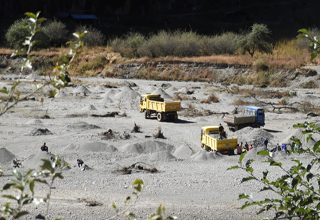[ Tongam Rina ]
ITANAGAR, Nov 22: There is persistent sand and gravel mining in Zemithang in Tawang district including the stretch which is the winter habitat of the Black-Necked Cranes. Locals say that the three kilometers stretch from Brokenthang to Zemithang on the Nyamjang Chhu, which is the site of the wintering habitat of the revered cranes has not been spared.
The ongoing sand-mining threatens the wintering habitat of the Black-necked Crane as the season for wintering of the Black-necked crane has now begun, said an environmentalist.
The cranes arrive during November-December and depart around February-March every year. So far, cranes are yet to arrive.
The Save Mon Region Federation’s General Secretary Lama Lobsang Gyatso has appealed to the Deputy Commissioner and Divisional Forest Officer of Tawang to stop the mining so that winter home of the Black-Necked Crane is not disturbed.
The Tawang Divisional Forest Officer, when contacted by this daily said that sand mining in the area is not under the purview of the Forest Department as it is unclassified forest area.
River bed mining requires forest and environment clearances from the Ministry of Environment, Forests and Climate Change since river bed is legally part of forest land. The environment clearance is required under District Environment Impact Assesement Authority (DEIAA), set-up as per EIA notification 2006.
However, the Divisional Forest Officer said that sand mining is under the Department of Minerals and Mining and not under Forest Department.
The district’s Mining Department did not respond to the text messages and calls till filing of this story. But, an official of the district administration said that mining is banned in the district following a notification by the NGT in 2013 while responding to petition on large scale illegal and mining activity in major rivers of the country.
In the past few years, the District Administration had restricted sand mining during the wintering season of the cranes but this year, the mining had started unabated since August.
Experts say that even if there is a legitimate demand to mine by the local villagers, it needs to be looked at in light of the fact that only a 3 km stretch of river is wintering ground of the Black-Necked Cranes.
A proper study will have to be carried out in consultation with local villagers whether sand-mining is sustainable at the site given its ecological sensitivity, Lama Lobsang said while speaking to this daily.
He blames the politicians and administration of the district for the mining, while stating that mining is being done right near the office of the administration.
A week ago, monks from the Tawang Monastery had visited the area to request the people of the area to stop mining. Lama Lobsang says that most of those involved in mining have political connections.
An official who did not wish to be named said that there is huge demand for sand and gravel in the district as large constructions, including roads and hotels are being undertaken. He said that communities are involved in mining to make money as the administration looks on.
The mining is happening right when the Wildlife Institute of India is currently conducting a study at the site on the crane as per the order of the National Green Tribunal (NGT).
Based on a petition filed by the monks of Tawang through the Save Mon Region Federation, NGT, last year had suspended the environmental clearance of the 780 MW Nyamjang Chhu Hydro-electric Project as the Environmental Impact Assessment report had failed to study impact on the Black-Necked Cranes.
The NGT had also acknowledged the cultural link of the bird with the Monpas as His Holiness, the 6th Dalai Lama had written about the bird in his poetry.
Zemithang and Sangti are the two wintering habitats of the Black-Necked Cranes. But due to habitat destruction and change in cultivation pattern, between 2009-13, the cranes did not arrive in Sangti. However, year later four cranes were sighted. During the same time, 25 birds made Zemithang their winter home.
Researchers of World Wildlife Fund-India, Aligarh Muslim University, Department of Wildlife Protection, Jammu and Kashmir, Wildlife Institute of India, Dehradun, University of Maryland and Tata Institute of Social Sciences in a study conducted between 2000-2014 which was published in the Zoological Research, had suggested that Sangti valley and Pangchen Valley of Zemithang should be declared as Black-necked Crane nature reserves and measures to maintain the ecological integrity of these areas should be taken on as a priority.
Zemithang and Sangti Valley are the two known wintering sites of Black-necked Crane in India, though a survey in 2016-17 by the Centre with Potential for Excellence in Biodiversity, Rajiv Gandhi University, Arunachal Pradesh to ascertain the numbers of Black-Necked Crane wintering sites led to sightings in Chug Valley, near Dirang in West Kameng.
Five were spotted in the rice fields of Chug valley last year, said Dr Daniel Mize who led the survey.
The survey also led to the sighting of a single black neck crane at Doblo River in Shergoan in the same district. The crane stayed there for a day. Either the cranes are looking for new sites or it was a case of vagrancy, Dr Mize said.
Though more than 15 cranes were sighted last year in the state, it was not a happy ending. Two cranes died after getting stuck at a high voltage power line at Sangti Valley. Since 2007, it was the second time that the power line became a deathtrap.
Dr Mize and other experts say that power lines should be shifted from the current location, which is the main site for the cranes, to make Sangti Valley more welcoming.
“The cranes do not like to be disturbed by humans or feral dogs, which has been the case in Sangti Valley. They like calm rice fields since they eat it and other open fields. Human interference in habitat area of the cranes is a huge danger”, he says.
Once Apatani valley was one of the favorite sites of these birds. Dr Mize says that a record 27 cranes came to Ziro in 1954. But slowly, they stopped coming. And since the 70’s, the birds stopped coming altogether.
The study by experts attributed the disappearance of the black-necked cranes from Apatani Valley to habitat loss, degradation and poaching. It appears that if enough precaution is not taken, the cranes will abandon Arunachal altogether.
(The black-necked crane is threatened birds that migrate from Tibet during the winter. It is classified as “vulnerable” in the list of endangered species of the International Union for Conservation of Nature (IUCN) and is in the schedule I Wildlife (Protection) Act, 1972. There are around 11000 cranes, approximately according to Wildlife International.)






